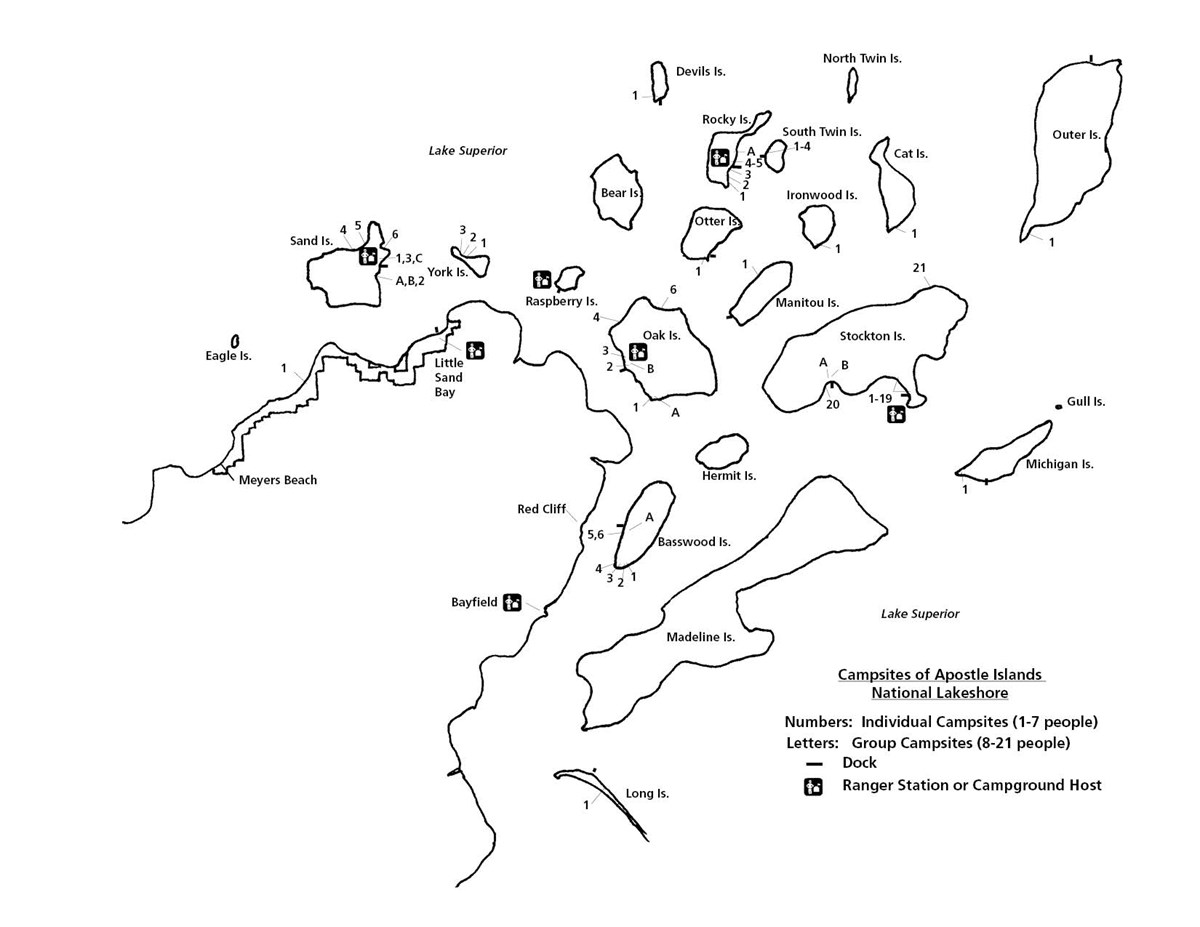Camping
The Apostle Islands Area offers remote wilderness camping as well as family camping both on and off the mainland. Popular camping destinations include
Big Bay State Park on Madeline Island, Little Sand Bay Campground, Stockton Island, and Buffalo Bay Campground in Red Cliff. Camping through the National Park Service (NPS) is available on 18 of the 21 islands and there is also one mainland location. A camping permit needs to be acquired for all the NPS campsites by calling (715) 779-3397. Individual campsites (one to seven people) can be reserved for $15 a night up to one month ahead of time. Group campsites (eight to 20 people) can be reserved after the first week of January.
Backcountry zones are also available on 15 of the islands for $15 a night. The zones are not shown on the campsite map, but are available at the visitor center. Only one group of up to 5 people is allowed in a zone per night. These zones require backpacking to the campsite and "Leave no Trace" camping techniques.
Visit the Apostle Islands National Park Service for Current Closures and to View Campsites
Important Camping Safety Tips for All Kinds of Campers
Camping is what you make it - and that can be a fun adventure or a miserable slog. It all depends on how prepared you are and how vigilant you are in your camping safety. Camping is a relatively safe activity for you and the family, but in the end it’s crucial to remember that you’re still venturing out into the woods. Here’s how to stay safe on your next excursion.
For backwoods campers: always be over-prepared
If you’re venturing off the beaten path for your camping trip and going deep into the backcountry, the best way to ensure your safety is to be over-prepared when it comes to your wilderness kit. Every camper needs to be mindful of their pack, but backwoods campers must make sure they can survive for a few days if something were to go wrong (injury, animal encounter, getting lost, etc.).
Your survival kit should include: a lighter, firestarter, a lightweight water carrier with 3 days of supply (maybe a camelbak), bear mace, a first aid kit, a compass or GPS device, and a multitool. Here’s a good survival kit walkthrough you should consider.
For family campers: respect the fire
A roaring campfire is needed for any successful camping trip. If you remember one thing about fire it should be this: you are never fully in control of a fire. Once you realize that, you’ll be a safer steward of its awesome power.
When it comes to fire, the main thing is to give it room. Always build your campfire at least 15 feet away from everything else - your tent, chairs, stacks of firewood, coolers, etc. Don’t forget to look up - you don’t want vegetation overhanging a fire. Never use any sort of flame inside a tent (like a camp stove). Make sure that you surround the fire with rocks or bricks. This is a safeguard against a fire spreading out of control.
A fire is never truly out until it is 100% out. Never leave a fire unattended (this means going to sleep in your tent) - even if it’s already died down to the point of just embers. You should always have two methods available to you to put out any fire - water and sand/dirt.
For hikers: tell someone where you’re going
It doesn’t matter if you’re a first-time hiker or a seasoned vet - it’s easier to get lost in the wilderness than you may think. Always tell someone where you are going hiking, how long you expect to be gone, and which trails you plan to take on. If you find yourself hopelessly lost in the woods without a real bearing on your whereabouts, you have a better chance of being found if you stay put - wandering usually leads you deeper in or around in circles.
For RV campers: be mindful of your electrical load and always get it pre-serviced
Never leave for an RV camping trip without knowing your RV is in tip top shape. RVs aren’t used as much as everyday vehicles, so they can fall into disrepair pretty fast. As ClosetBox.com suggests, some vital components to check include the brakes, wheel bearings, tire PSI, and air conditioning coils and filters.
It’s easy to fall into the “glam” experience when using an RV and take advantage of the fact that you have outlets galore - but be mindful of this. As TripSavvy.com notes, most RVs aren’t wired to run many electrical items at once. Be careful of the strain you’re putting on your RV’s electrical system.
Camping can be enjoyed in a variety of ways - backwoods, with your family in a prepared campsite, in an RV, or for multiple days on a hiking excursion. You can stay safe in your adventures by being prepared (over is better than under), respecting fire, letting loved ones know your plans, and making safe electrical use choices when it comes to your RV.



